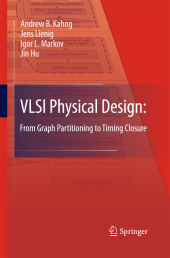 Neuerscheinungen 2014Stand: 2020-02-01 |
Schnellsuche
ISBN/Stichwort/Autor
|
Herderstraße 10
10625 Berlin
Tel.: 030 315 714 16
Fax 030 315 714 14
info@buchspektrum.de |

Andrew B. Kahng, Jens Lienig, Igor L. Markov
(Beteiligte)
VLSI Physical Design: From Graph Partitioning to Timing Closure
2011. 2014. xi, 310 S. 235 mm
Verlag/Jahr: SPRINGER NETHERLANDS; SPRINGER, BERLIN 2014
ISBN: 9400790201 (9400790201)
Neue ISBN: 978-9400790209 (9789400790209)
Preis und Lieferzeit: Bitte klicken
LSI Physical Design explores how algorthims can be used to create a geometric chip layout can be created from an abstract circuit design. The text emphasizes essential, fundamental techniques, ranging from hypergraph partictioning and circuit placement to timing closure.
Design and optimization of integrated circuits are essential to the creation of new semiconductor chips, and physical optimizations are becoming more prominent as a result of semiconductor scaling. Modern chip design has become so complex that it is largely performed by specialized software, which is frequently updated to address advances in semiconductor technologies and increased problem complexities. A user of such software needs a high-level understanding of the underlying mathematical models and algorithms. On the other hand, a developer of such software must have a keen understanding of computer science aspects, including algorithmic performance bottlenecks and how various algorithms operate and interact.
"VLSI Physical Design: From Graph Partitioning to Timing Closure"
introduces and compares algorithms that are used during the physical design phase of integrated-circuit design, wherein a geometric chip layout is produced starting from an abstract circuit design. The emphasis is on essential and fundamental techniques, ranging from hypergraph partitioning and circuit placement to timing closure.
1 Introduction. 1.1 Electronic Design Automation (EDA). 1.2 VLSI Design Flow. 1.3 VLSI Design Styles. 1.4 Layout Layers and Design Rules. 1.5 Physical Design Optimizations. 1.6 Algorithms and Complexity. 1.7 Graph Theory Terminology. 1.8 Common EDA Terminology.
2 Netlist and System Partitioning. 2.1 Introduction. 2.2 Terminology. 2.3 Optimization Goals. 2.4 Partitioning Algorithms. 2.5 A Framework for Multilevel Partitioning. 2.6 System Partitioning onto Multiple FPGAs. Chapter 2 Exercises.
3 Chip Planning. 3.1 Introduction to Floorplanning. 3.2 Optimization Goals in Floorplanning. 3.3 Terminology. 3.4 Floorplan Representations. 3.5 Floorplanning Algorithms. 3.6 Pin Assignment. 3.7 Power and Ground Routing. Chapter 3 Exercises.
4 Global and Detailed Placement. 4.1 Introduction. 4.2 Optimization Objectives. 4.3 Global Placement. 4.4 Legalization and Detailed Placement. Chapter 4 Exercises.
5 Global Routing. 5.1 Introduction. 5.2 Terminology and Definitions. 5.3 Optimization Goals. 5.4 Representations of Routing Regions. 5.5 The Global Routing Flow. 5.6 Single-Net Routing. 5.7 Full-Netlist Routing. 5.8 Modern Global Routing. Chapter 5 Exercises.
6 Detailed Routing. 6.1 Terminology. 6.2 Horizontal and Vertical Constraint Graphs. 6.3 Channel Routing Algorithms. 6.4 Switchbox Routing. 6.5 Over-the-Cell Routing Algorithms. 6.6 Modern Challenges in Detailed Routing. Chapter 6 Exercises.
7 Specialized Routing. 7.1 Introduction to Area Routing. 7.2 Net Ordering in Area Routing. 7.3 Non-Manhattan Routing. 7.4 Basic Concepts in Clock Networks. 7.5 Modern Clock Tree Synthesis. Chapter 7 Exercises.
8 Timing Closure. 8.1 Introduction. 8.2 Timing Analysis and Performance Constraints. 8.3 Timing-Driven Placement. 8.4 Timing-Driven Routing. 8.5 Physical Synthesis. 8.6 Performance-Driven Design Flow. 8.7 Conclusions. Chapter 8 Exercises.
A Solutions to Chapter Exercises. B Example CMOS Cell Layouts.


